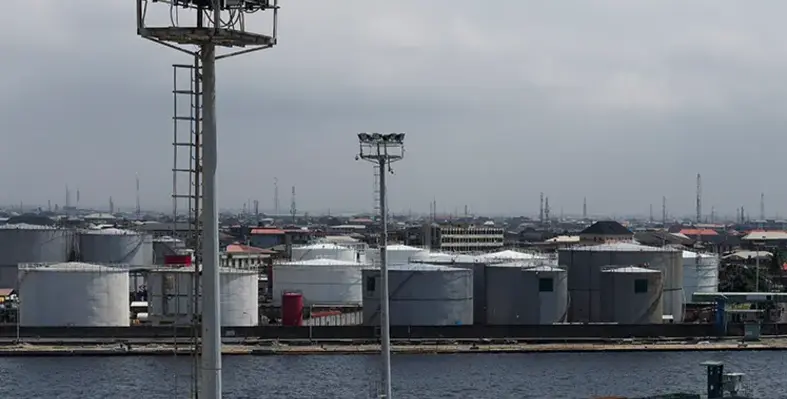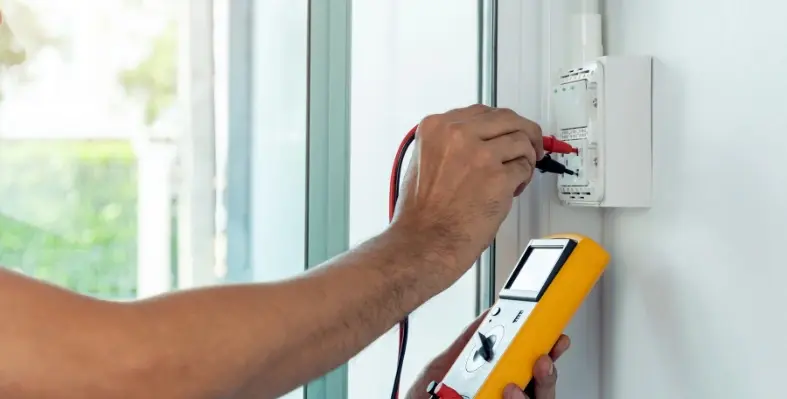Energy
Hydrogen and helium drive future innovation
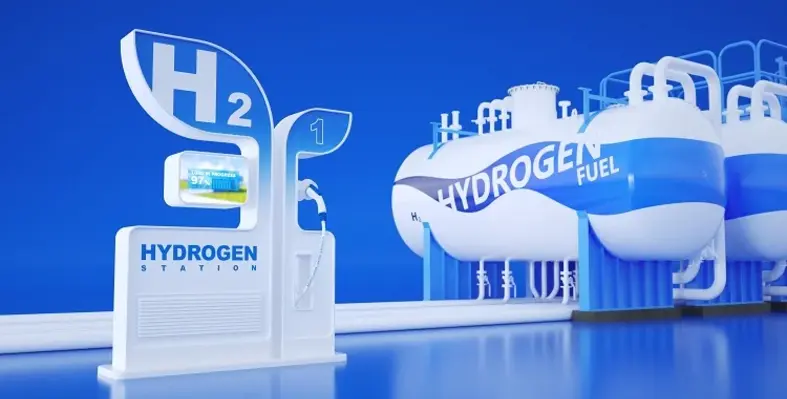
Hydrogen and helium may be made up of small molecules but have a big role to play in the technology innovations of the future
From the natural gas that underpins power generation to the carbon dioxide emissions driving the climate crisis, there is no denying gases have a significant impact on modern life, according to Eve Pope, senior technology analyst at IDTechEx
The two lightest gases - hydrogen and helium - may be made up of small molecules but have a big role to play in the technology innovations of the future. Key application areas include mobility, power generation, and semiconductor manufacturing.
Hydrogen power
Hydrogen is an energy carrier that could replace fossil fuels to power the future. Fuel cells can convert hydrogen gas into electricity through a chemical reaction with oxygen. Because solid oxide fuel cells have a long operating lifetime and fuel flexibility, they are well-suited to the continuous power generation required for sustainable data centres. As the AI boom continues, some data centres are already using solid oxide fuel cells running on natural gas, with plans to transition over to low-carbon hydrogen once economics and infrastructure can make this commercially feasible.
For cars, fuel cell electric vehicles can also be powered by the reactions between stored hydrogen and oxygen in the air. Markets for fuel cell electric vehicles will depend upon national investments in green hydrogen projects and rollouts of hydrogen refueling stations.
Industrial decarbonisation of iron and steel enabled by hydrogen
For iron and steel, natural gas direct reduced iron (DRI) production using shaft furnaces is already mature. Hydrogen-based DRI (H2-DRI) processes represent the next logical evolution toward greener steel production. Midrex and Energiron shaft furnace plants have successfully demonstrated the use of hydrogen or hydrogen-rich gases, as evidenced in projects like HYBRIT by SSAB in Sweden and HBIS Group in China.
The success of hydrogen-based green steel production will depend heavily upon the availability of green and blue hydrogen and supporting infrastructure, with IDTechEx’s “Green Steel 2025-2035: Technologies, Players, Markets, Forecasts” report forecasting that 46 million tonnes of steel will be produced enabled by hydrogen in 2035.
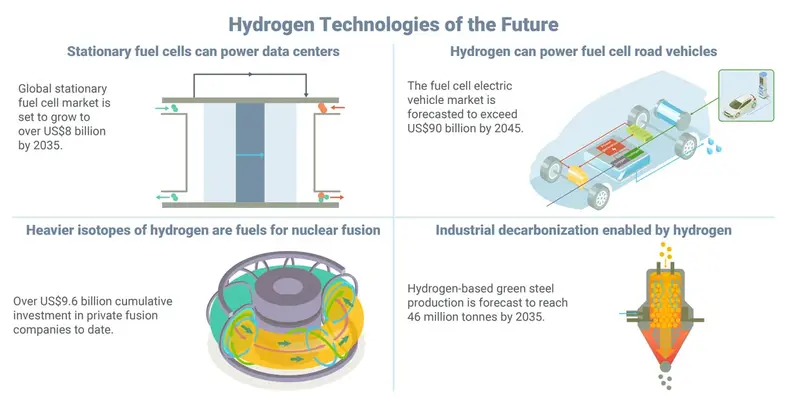 Hydrogen isotopes for nuclear fusion
Hydrogen isotopes for nuclear fusion
Even the heavier isotopes of hydrogen have a role to play. Deuterium and tritium are essential fuels for nuclear fusion technologies, hoped to provide energy-dense, continuous sources of green energy with no risk of meltdown. According to IDTechEx’s “Fusion Energy Market 2025-2045: Technologies, Players, Timelines” report, commercial fusion companies have raised over US$9bn to date, while an increasing number of governments see fusion as the modern day 'space race'. Players are pursuing different reactor designs and fuels, leading to various materials opportunities and supply chain challenges.
Helium required for semiconductor manufacturing
Helium is widely used in manufacturing processes due to its cooling and inert properties. It is crucial for thermal management during semiconductor production. As semiconductor manufacturing advances towards smaller nodes (essential for AI, autonomous vehicles, etc.), reliance on helium will continue to grow. Helium is a finite resource, so technologies for helium production and helium substitutes covered in IDTechEx’s “Helium for Semiconductors and Beyond 2025-2035: Market, Trends, and Forecasts” report will become increasingly essential.
Materials key to hydrogen and helium production
From the ion exchange membranes in electrolyzers for green hydrogen generation to the gas separation membranes used in helium and hydrogen production, the applications explored in this article represent significant opportunities for chemicals and materials companies. Materials for green hydrogen are needed for components such as catalysts, electrodes, porous transport layers, gas diffusion layers, bipolar plates, and gaskets. Innovations include new catalysts with less iridium content to cut costs. For gas separation membranes, the development of new palladium-alloy metallic membranes could unlock ultra-pure H2 separation.
Ethiopia inaugurates GERD mega dam
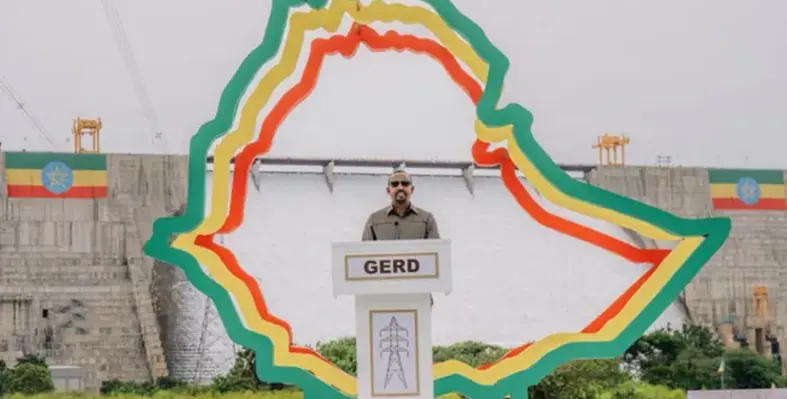
Inauguration of the Grand Ethiopian Renaissance Dam (Image source: Office of the Prime Minister of Ethiopia)
Ethiopia has officially inaugurated its US$5bn Grand Ethiopian Renaissance Dam (GERD), almost a decade and a half after initial work commenced back in 2011
Africa's largest hydroelectric dam, electricity production has slowly increased since the first turbine was switched on in 2022, to now reach a maximum of 5,150MW of power.
The main dam, 170 metres high and 1,800 metres long, is the largest gravity dam in rolled concrete ever built in Africa.
Ethiopia now hopes the mega project — among the 20 biggest hydroelectric dams in the world — will provide energy to millions across the region.
At a ceremony at the site in Guba, Ethiopia’s Prime Minister Abiy Ahmed addressed a crowd of gathered dignitaries including the presidents of Somalia, Djibouti and Kenya— though not those of Egypt and Sudan, which have long expressed concerns about the project.
Egypt, which built its own Aswan High Dam on the Nile in the 1960s, fears it could restrict its water supply during droughts, and could encourage the construction of other upstream dams.
“To our [Sudanese and Egyptian] brothers; Ethiopia built the dam to prosper, to electrify the entire region and to change the history of black people,” said Abiy. “It is absolutely not to harm its brothers.”
Abiy added that the dam will improve access to electricity for almost half the population who had none as recently as 2022, as well export surplus energy to the region.
The project was designed and built by Italy-based Webuild - Webuild's CEO Pietro Salini also attended the inauguration event.
It has now completed 30 projects in Ethiopia, with a strong focus on the hydroelectric sector.
Others include the Beles Multipurpose Project, with an underground hydroelectric power plant — the largest in the country at the time of its inauguration — and the Gibe III dam on the Omo River, standing 250 meters high, which at the time of its opening was the highest RCC dam in the world.
Construction is currently underway for the Koysha Dam, the second largest hydroelectric project in Ethiopia after GERD, which will further contribute to the country's energy transition.
Read more:
Dangote to build urea factory in Ethiopia
JB4 Bredell Campus sets new power benchmark
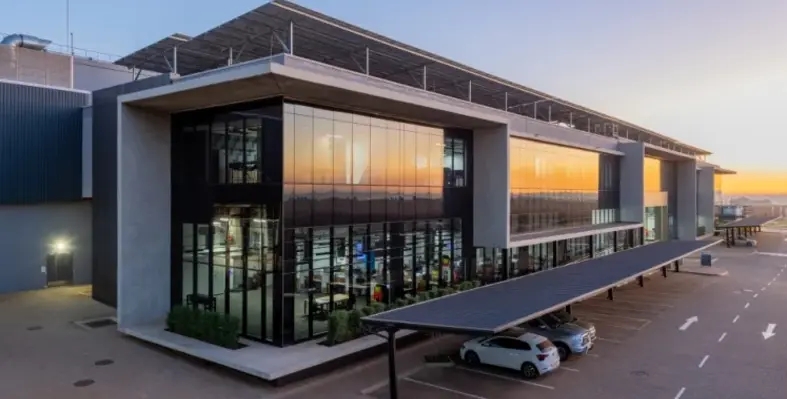
Teraco completes JB4 Bredell Campus expansion in South Africa, adding 30MW critical IT power for hyperscale clients. (Image source: Teraco)
Teraco: A Digital Realty Company, Africa’s leading interconnection hub and vendor-neutral data centre provider, has announced the completion of its JB4 Bredell Campus expansion in Ekurhuleni, east of Johannesburg
The expansion adds 30MW of IT power capacity, making JB4 the largest standalone data centre in Africa, supporting 50MW of critical IT load. This new phase comprises six data halls, featuring multiple design enhancements. Notably, each hall now accommodates 5MW of allocated critical IT power, a first for the African market. The halls are fully liquid-to-liquid cooling enabled, supporting high-density air-cooled cloud deployments and direct-to-chip cooling for AI workloads.
Designed with sustainability in mind, JB4 uses a closed-loop chilled water system that delivers free air cooling. AI-enabled technology adjusts data hall cooling in real time according to IT load and dispersion. This innovative setup achieves best-in-class Power Usage Effectiveness (PUE), reducing energy consumption while eliminating water use during ongoing cooling—a crucial feature in a region with water scarcity challenges.
The JB4 expansion, built to hyperscale specifications, significantly boosts South Africa’s and sub-Saharan Africa’s data centre footprint. This follows the recent completion of Teraco’s JB5 Isando facility, which adds another 30MW of critical IT power at the Isando Campus.
Jan Hnizdo, Teraco CEO, commented, “South Africa has become the technology and data centre hub for sub-Saharan Africa, acting as a springboard for cloud, AI and content provision into Africa. Massive global investments in undersea cables, such as Equiano and 2Africa, further strengthen this position. This will enable global cloud providers to service not only the South African market but also the rest of the sub-Saharan African region.”
“Teraco is dedicated to expanding its capacity across key hubs, ensuring our clients have the flexibility to scale and fully leverage digital transformation across the region. We continue to make significant investments in ICT infrastructure and have established Africa’s largest data centre platform. We are proud to offer open-access interconnection and deliver world-class data centre solutions to all our clients,” added Hnizdo
Situated in the heart of Ekurhuleni’s Aerotropolis, the JB4 facility provides access to numerous network service providers, regional IXPs, content delivery networks, cloud service on-ramps, and peering at NAPAfrica, the world’s eighth-largest internet exchange.
Teraco’s data centre platform now totals 189MW of critical power load across the Isando Campus (JB1/JB3/JB5: 70MW), Bredell Campus (JB2/JB4: 64MW), Cape Town Campus (CT1/CT2: 53MW), and Durban (DB1: 2MW). Local and global organisations increasingly rely on Teraco to scale IT infrastructure, deploy hybrid multi-cloud architectures, and connect with strategic business partners within the Platform Teraco ecosystem. The addition of JB4 strengthens this ecosystem, offering enterprises a secure, high-performance, and reliable platform for IT deployment, providing access to the broadest range of carriers and network service providers—a foundation for resilient and future-ready interconnection strategies.
Next-generation Rheem Centurion boosts energy efficiency
Rheem Middle East, a global leader in HVAC and water-heating solutions, has introduced Rheem Centurion, a next-generation system designed to set new performance standards in heating and cooling across the MEA region.
Engineered for maximum efficiency, Rheem Centurion delivers up to 84% energy savings by recycling waste heat from air conditioning units to produce hot water while cooling indoor spaces at the same time. This dual functionality helps reduce energy costs, cut carbon emissions, and ensure reliable year-round performance for residential, commercial, and hospitality applications.
Tailored to the region’s climate and sustainability priorities, Rheem Centurion supports energy-smart building technologies in line with regulatory requirements and long-term green goals. As urbanisation, population growth, and large-scale developments accelerate across the MEA, the system offers developers and operators a future-proof solution that balances comfort with sustainability.
Versatility is central to its design. Rheem Centurion integrates seamlessly into a wide range of building types and can heat water up to 70°C, making it particularly suitable for high-demand facilities such as hotels, hospitals, resorts, and multi-family housing. Its advanced smart controller enables users to optimise efficiency through three operating modes—cooling, heating, or simultaneous use—while maintaining whisper-quiet operation to enhance indoor comfort.
By capturing and reusing otherwise wasted energy, Rheem Centurion not only supports cost savings but also delivers measurable environmental benefits, positioning it as a key innovation for sustainable infrastructure across the MEA region.
Brian Hempenstall, vice president and general manager at Rheem Middle East, said, “Rheem Centurion is more than a product launch; it represents a significant step forward for the built environment in this region. By combining air conditioning and hot water generation in a single, highly efficient system, we are helping developers, hoteliers, and homeowners meet today’s demands while preparing for tomorrow’s sustainability standards. At Rheem, our mission is to deliver comfort without compromise — comfort that is smarter, cleaner, and built for the future of the Middle East and Africa.”





